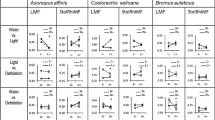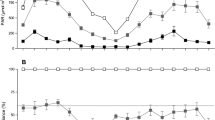Abstract
The biomass allocation pattern in plants is known to depend on the below and above-ground resource availabilities. In a herbaceous multi-species stand, it can be expected that the effects of nutrient and light availability on plants’ general space-use strategy are fundamentally different. We hypothesized that nutrient status alters the amount of biomass produced per unit canopy volume (biomass density), but not so much the biomass vertical distribution pattern. Changes in light availability, in contrast, should affect the vertical distribution pattern of biomass but not biomass density. We were also interested in whether the effect of resource manipulation on a plant’s space-use strategy depends on its basic morphological characteristics (growth form).
The results from a four-year permanent plot experiment in a species-rich grassland, with fertilization and additional illumination from mirrors applied to 40 × 40 cm plots, showed that our main hypothesis was correct. Fertilization significantly affected biomass density above as well as below-ground, while additional illumination generally did not. Light addition altered the vertical distribution pattern of above-ground biomass, which remained unaffected by the fertilizer treatment.
The effects of resource manipulations on plants’ space-use strategy were strongly dependent on the basic morphological traits of species. Plants with a leafy stem (grasses and upright forbs) could significantly increase their above-ground biomass density with fertilization, while the ones without a leafy stem (sedges and rosette-forming forbs) could not. Additional illumination, however, significantly increased the amount of biomass per unit canopy volume only in species with narrow leaves (graminoids). The space-use strategy and vertical allocation pattern of extra resources clearly depend on the balance between light and nutrient resources and on plants’ growth forms.
Similar content being viewed by others
References
Aerts R., Boot R.G.A. &van der Aart P.J.M. (1991): The relation between above- and belowground biomass allocation patterns and competitive ability.Oecologia 87: 551–559.
Calhill J.F. (2003): Lack of relationship between below-ground competition and allocation to roots in 10 grassland species.J. Ecol. 91: 532–540.
Casper B.B., Calhill J.F. &Hyatt L.A. (1998): Above-ground competition does not alter biomass allocated to roots inAbutilon theophrasti.New Phytol. 140: 231–238.
Cody M.L. (1991): Niche theory and plant growth form.Vegetatio 97: 39–55.
Corré W.J. (1984): Growth and morphogenesis of sun and shade plants IV. Competition between sun and shade plants in different light environments.Acta Bot. Neerl. 33: 25–38.
Day K.J., Hutchings M.J. &John E.A. (2003): The effects of spatial pattern of nutrient supply on yield, structure and mortality in plant populations.J. Ecol. 91: 541–553.
Dong M. &de Kroon H. (1994): Plasticity in morphology and biomass allocation inCynodon dactylon, a grass species forming stolons and rhizomes.Oikos 70: 99–106.
Dong M., During H.J. &Werger M.J.A. (1996): Morphological responses to nutrient availability in four clonal herbs.Vegetatio 123: 183–192.
Eek L. &Zobel K. (1997): Effects of additional illumination and fertilization on seasonal changes in fine-scale grassland community structure.J. Veg. Sci. 8: 225–234.
Eek L. &Zobel K. (2001): Structure and diversity of a species-rich grassland community, treated with additional illumination, fertilization and mowing.Ecography 24: 157–164.
Hirose T. &Werger M.J.A. (1995): Canopy structure and photon flux partitioning among species in an herbaceous plant community.Ecology 76: 466–472.
Hirose T., Werger M.J.A., Pons T.L. &van Rheenen J.W.A. (1988): Canopy structure and leaf nitrogen distribution in a stand ofLysimachia vulgaris L. as influenced by stand density.Oecologia 77: 145–150.
Huante P., Rincón E. &Chapin F.S. III (1998): Foraging for nutrients, responses to changes in light, and competition in tropical deciduous tree seedlings.Oecologia 117: 209–216.
Huber H. &Hutchings M.J. (1997): Differential response to shading in orthotropic and plagiotropic shoots of the clonal herbGlechoma hirsuta.Oecologia 112: 485–491.
Huber H. &Wiggerman L. (1997): Shade avoidance in the clonal herbTrifolium fragiferum: a field study with experimentally manipulated vegetation height.Pl. Ecol. 130: 53–62.
Körner C. (1991): Some often overlooked plant characteristics as determinants of plant growth: a reconsideration.Funct. Ecol. 5: 162–173.
Krall H. &Pork K. (1970): Laelatu puisniit (Laelatu wooded meadow). In:Kumari E. (eds.),Lääne-Eesti rannikualade loodus (Coastal nature of West-Estonia), Valgus, Tallinn, pp. 115–116.
Kull O. &Aan A. (1997): The relative share of graminoid and forb life forms in a natural gradient of herb layer productivity.Ecography 20: 146–154.
Kull K. &Zobel M. (1995): Kas on veel ruumi? Ei, kőik on täis (Is there any space left? No, there is not).Eesti Loodus (Estonian Nature) 48: 711–714.
Leht M. (1999):Eesti taimede määraja (Plant species in Estonia). Eesti Loodusfoto, Tartu.
Li B., Suzuki J. &Hara T. (1999): Competitive ability of twoBrassica varieties in relation to biomass allocation and morphological plasticity under varying nutrient availability.Ecol. Res. 14: 255–266.
Liira J. &Zobel K. (2000): The species richness — biomass relationship in herbaceous plant communities: what difference does the incorporation of root biomass data make.Oikos 91: 109–114.
Liira J., Zobel K., Mägi R. &Molenberghs G. (2002): Vertical structure of herbaceous canopies: the importance of plant growth form and species-specific traits.Pl. Ecol. 163: 123–134.
Machado J.L. &Reich P.B. (1999): Evaluation of several measures of canopy openness as predictors of photosynthetic photon flux density in deeply shaded conifer-dominated forest understory.Canad. J. Forest Res. 29: 1438–1444.
McConnaughau K.D.M. &Coleman J.S. (1999): Biomass allocation in plants: ontogeny or optimality? A test along three resource gradients.Ecology 80: 2581–2593.
Mitchley J. &Willems J.H. (1995): Vertical canopy structure of Dutch chalk grasslands in relation to their management.Vegetatio 117: 17–27.
Mitchell P.L. &Woodward F.I. (1988): Responses of three woodland herbs to reduced photosynthetically active radiation and low red to far-red ratio in shade.J. Ecol. 76: 807–825.
Rajaniemi T.K., Allison V.J. &Goldberg D.E. (2003): Root competition can cause a decline in diversity with increased productivity.J. Ecol. 91: 407–416.
Ryser P. (1998): Intra- and interspecific variation in root length, root turnover and the underlying parameters. In:Lambers H., Poorter H. &van Vuuren M.M.I. (eds.),Inherent variation in plant growth, Physiological mechanisms and ecological consequences, Backhuys Publishers, Leiden, The Netherlands, pp. 441–465.
Ryser P. &Eek L. (2000): Consequences of phenotypic plasticity vs. interspecific differences in leaf and root traits for acquisition of aboveground and belowground resources.Amer. J. Bot. 87: 402–411.
Shibaike H., Ishiguri Y. &Kawano S. (1996): Plastic responses to nutrient and light intensity gradients in populations ofOxalis corniculata L. (Oxalidaceae).Pl. Species Biol. 11: 213–223.
Stuefer J.F. &Huber H. (1998): Differential effects of light quantity and spectral light quality on growth, morphology and development of two stoloniferousPotentilla species.Oecologia 117: 1–8.
Sultan S.E. (1995): Phenotypic plasticity and plant adaptations.Acta Bot. Neerl. 44: 363–383.
Tucić B., Tomić V., Avramov S. &Pemac D. (1988): Testing the adaptive plasticity ofIris pumila leaf traits to natural light conditions using phenotypic selection analysis.Acta Oecol. 19: 473–481.
Urbas P. &Zobel K. (2000): Adaptive and inevitable morphological plasticity of three herbaceous species in a multi-species community: Field experiment with manipulated nutrients and light.Acta Oecol. 21: 139–147.
van Hinsberg A. &van Tienderen P. (1997): Variation in growth form in relation to spectral light quality (red/far-red ratio) inPlantago lanceolata L. in sun and shade populations.Oecologia 111: 452–459.
Wetzel P. R. &Van der Valk A. G. (1998): Effects of nutrient and soil moisture on competition betweenCarex stricta, Phalaris arundinacea, andTypha latifolia.Pl. Ecol. 138: 179–190.
Zobel K. &Liira J. (1997): A scale-independent approach to the richness vs biomass relationship in ground-layer plant communities.Oikos 80: 325–332.
Author information
Authors and Affiliations
Corresponding author
Rights and permissions
About this article
Cite this article
Lepik, M., Liira, J. & Zobel, K. The space-use strategy of plants with different growth forms, in a field experiment with manipulated nutrients and light. Folia Geobot 39, 113–127 (2004). https://doi.org/10.1007/BF02805241
Received:
Revised:
Accepted:
Issue Date:
DOI: https://doi.org/10.1007/BF02805241




